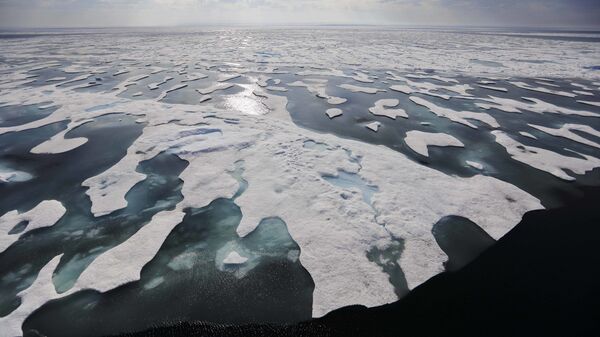Sea ice extent is the total area in which ice concentration is at least 15%, according to NASA. Analysis of satellite data shows that the Arctic ice cap’s extent has shrunk to an area of 1.44 million square miles this year, the second-lowest minimum on record. Sea ice volume, on the other hand, is calculated as thickness multiplied by concentration and area.
“The fact that volume is also declining, and declining rapidly even relative to extent, suggests that we are headed in the wrong direction and have been for quite some time. Looks like this is just about the worst news you could possibly bring to people on the radio,” Guy McPherson, scientist and professor emeritus of natural resources and ecology at the University of Arizona, told Radio Sputnik’s Political Misfits hosts Michelle Witte and Bob Schlehuber.
“Volume is down three-quarters since the mid-1980s. So shortly after measurements began - satellite measurements, in 1979 - the volume was what we would consider to be ‘normal.’ And here we are a mere 3-3.5 decades later, and the volume is down by three-quarters, and the thickness of sea ice is down by 99%. Whereas there used to be a tremendous amount of ice that was more than 4 meters thick, now, almost all of the ice is less than a meter thick … These are hugely important numbers that we do not hear enough about,” McPherson added.
In a journal article titled “Extremes become routine in an emerging new Arctic” recently published in the journal Nature Climate Change, researchers warn that the rapidly warming Arctic is undergoing “tremendous changes in sea ice, ocean and terrestrial regions.”
McPherson noted that in their work, the researchers “point toward the Arctic transitioning from one dominated by ice to one dominated by rain and open water on the sea circuit. We are already losing habitat for humans around the globe, especially in tropical and subtropical regions.” He added that changes in the Arctic could also threaten food security due to reduction in water availability and extreme weather event disasters.
“Grain crops for the basis for every civilization going back thousands of years, including this one. We absolutely need a soybean harvest and a corn harvest, a maize harvest this year, this fall, that matches or exceeds previous harvests. I haven’t seen any indication that that’s going to happen.” McPherson noted.
“That’s hugely important, because that’s how every civilization in the past and this one have gotten through and are going to get through the so-called hard times. It’s the ability to store certain foods in dry storage where you don’t need special, extreme conditions that allow us to get through,” he added.
Despite the dire effects of climate change, US President Donald Trump has tapped Ryan Maue, a meteorologist who has questioned the connection between extreme weather and climate change, to be the new chief scientist at the National Oceanic and Atmospheric Administration, Democracy Now reported Tuesday.
“To put a climate denier in charge of such an important body at this time in history, that’s obviously insane,” McPherson noted.
“Distraction and denial are more important than actual facts. And this is not the first time the Trump administration has revealed itself as being uninterested in facts, uninterested in scientific evidence, and so it shouldn't come as a big surprise. And yet this administration continues to surprise,” McPherson added.



